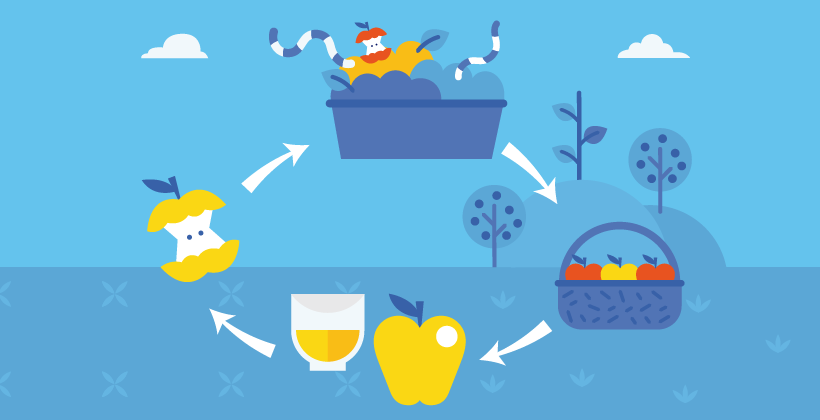Fighting food waste by innovative food packaging
Last Updated : 19 July 2018By 2050, the world’s population will have reached 9 billion people. To provide enough nutritious food for everybody, while preserving natural resources, we need to switch to more sustainable food systems. This not only involves changing how we produce food globally, but also reducing food losses and waste in the food chain and minimizing the impact of packaging waste.1
Every year, approximately one third of the global food production is lost. Losses happen at all stages of the food chain and across all types of foods, mainly due to spoilage. Food safety is also a rising concern: microbial contamination of food products is still the main cause of foodborne illnesses. Additional challenges are market globalisation which requires longer shelf-lives and the growing demand for minimally-processed foods. There is therefore a need to develop innovative materials to package foods that can guarantee safety and maintain quality for longer periods of time to reduce food waste. To respond to these challenges, food packaging technology is continuously evolving.1,2 Table 1 displays an overview of the possible technological innovations to prevent food waste in the future.
Table 1. Overview of technological innovations in food packaging to prevent food waste (adapted from reference 4). |
|
From passive to active
The role of food packaging is changing from passive – being a mere container protecting its contents from moisture, air, microbes and mechanical damage (such as vibration and shock), to active – capable of extending shelf life by interacting with the product, for example by releasing antioxidants, antimicrobials or oxygen scavengers to prevent food spoilage.3
Nanotechnology is increasingly being explored as a tool for developing active food packaging.4 NanoPack is an EU-funded project developing an active packaging film with antimicrobial properties. The novel packaging films slowly release tiny amounts of antimicrobial essential oils as a vapour into the so-called “headspace” of the packaging, thereby sanitizing both the food product and the headspace, and extending the shelf life of the product. Preliminary results have shown that NanoPack films are able to increase the shelf-life of additive free bread by 3 weeks, demonstrating the potential of active packaging systems to decrease food waste.
High barrier, yet biodegradable – a tricky balance
High barrier packaging materials are a highly desirable in the food packaging world, as they offer a strong resistant mechanical barrier to water and oxygen and pathogens, and can therefore extend shelf life while using fewer preservatives. However, these materials are often produced from non-renewable fossil-based sources and are not biodegradable. Sustainable disposal or recycling methods are often limited for materials containing several different functional layers. Moreover, the environmental impact of persistent plastic packaging waste in particular is raising general global concern. As such there is a growing trend towards more sustainable options with a lower environmental impact.3,5
However, making this switch while maintaining the properties of traditional high-barrier packaging materials such as plastics and metallised films is easier said than done. Bio-based packaging materials are increasingly being explored as environmentally-friendly substitutes for traditional plastic packaging due to increased biodegradability or compostability. However, their industrial use and application is still limited due to their less effective barrier properties (for example increased permeability to water or air.) These properties need to be improved considerably if they are to replace traditional plastics and help manage the world’s waste problem.1,5
To tackle this issue, EU-funded project RefuCoat aims to develop two novel types of bio-based food packaging. The first is a fully-recyclable active packaging replacement for metallised films that are currently used for packing cereals and crisps and savory snacks. The second will be a fully biodegradable package for chicken meat products. In this way, this project aims to improve shelf-life of fresh food produce while reducing the volume of packaging waste that goes to landfill.
Using waste to reduce waste
Another innovative idea to increase the sustainability of food packaging is to make it out of by-products from the food industry that would otherwise end up as waste. YPACK, an EU-funded project that started in November 2017, is currently developing a fully recyclable flow pack film and a fully biodegradable packaging tray using by-products that would usually go to waste such as unpurified cheese whey and almond shells. The flow pack film will function as a passive barrier and the tray will have active antimicrobial properties, capable of extending the shelf-life of food products.
Sustainable packaging towards sustainable food systems
With around a third of the food globally produced wasted, half of which at the consumption level, the time to act is now. Active packaging systems allow food to be transported for longer, minimising losses and waste associated with food spoilage, while other innovative ideas allow reduction of packaging waste itself, or turn waste from other sources into valuable resources. These technological innovations will be a crucial tool in the global fight against food waste, as we move towards a more sustainable future.
References
- Russell, D. A. M. Sustainable (food) packaging – an overview. Food Addit. Contam. Part A 31, 396–401 (2014).
- Realini, C. E. & Marcos, B. Active and intelligent packaging systems for a modern society. Meat Sci. 98, 404–419 (2014).
- Dainelli, D., Gontard, N., Spyropoulos, D., Zondervan-van den Beuken, E. & Tobback, P. Active and intelligent food packaging: legal aspects and safety concerns. Trends Food Sci. Technol. 19, S103–S112 (2008).
- Sozer, N. & Kokini, J. L. Nanotechnology and its applications in the food sector. Trends Biotechnol. 27, 82–89 (2009).
- Rhim, J.-W., Park, H.-M. & Ha, C.-S. Bio-nanocomposites for food packaging applications. Prog. Polym. Sci. 38, 1629–1652 (2013).



